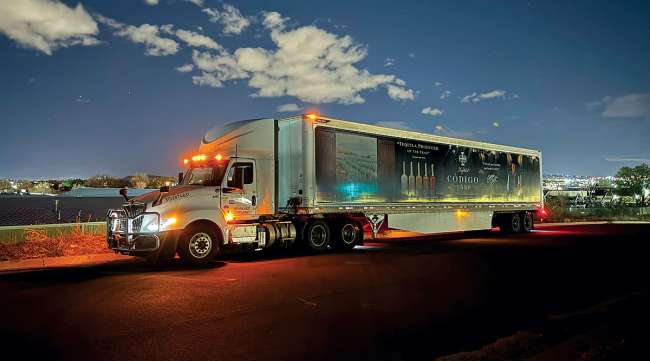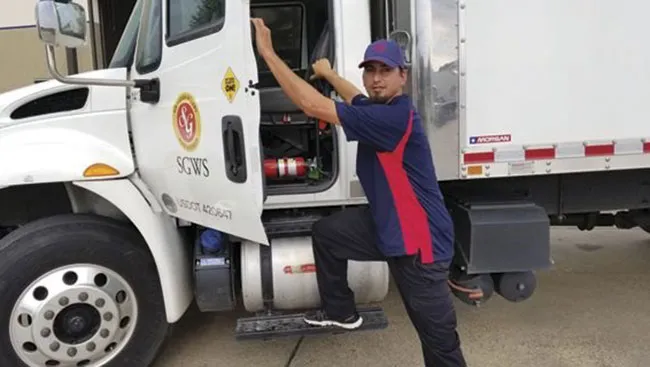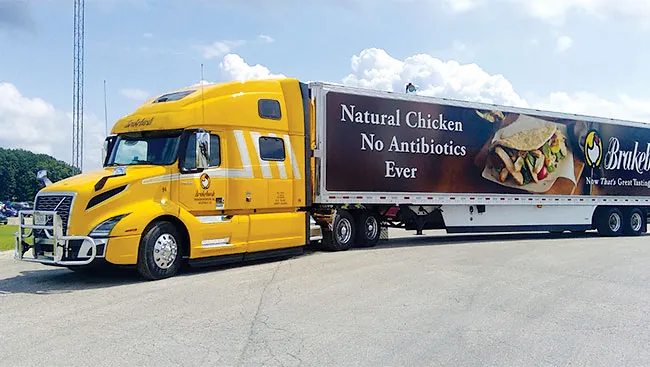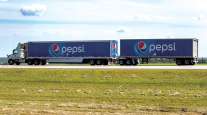Special to Transport Topics
Going Private: Shippers Strengthening In-House Fleets

[Stay on top of transportation news: Get TTNews in your inbox.]
Even at a time when for-hire truck capacity is readily available at competitive rates, many shippers have continued to invest in their own private fleets rather than taking full advantage of freight market conditions that have favored them for the past two years.
For these companies, maintaining or expanding an in-house fleet operation is a way to strengthen customer service, assume greater control over their supply chains and protect themselves from future shifts in the trucking market.
This approach to transportation planning has been shaped by the disruptions and demand cycles of the recent past, said Gary Petty, president and CEO of the National Private Truck Council.
He recalled a seminal moment several years ago that foreshadowed a foundational change in how businesses considered private fleets.
“It was 2018, a bleak time in the freight markets,” Petty remembered. “Demand was far higher than capacity. You couldn’t find trucks. Some cargo could not get delivered at any price. Rates went extraordinarily beyond cyclical increases of previous periods when there were shortfalls in capacity.”
See the 2024 Top 100 rankings
►Sector Lists Reflect Fleet Growth
Sector Rankings
Food Service | Grocery | Beverage
Petroleum/Chemical | Industrial Gases
Wholesale/Retail | Manufacturing
Equipment Rental | Building Materials
Waste Management | Construction
Paper/Office Products | Health Care
Uniform Rental | Media & Entertainment
That caught a lot of shippers off guard, he said, “not only those [private fleet operators] who used outside carriers to move excess loads, but in particular, those who were depending totally on for-hire.”
That market period created a hard shift in thinking — and eventually in practice — among many shippers regarding how they set their transportation procurement strategies.
“There was a sense of capacity vulnerability they had never before seen to this extreme,” Petty said. “And if you can’t get capacity at any cost, that means you better look internally to your own resources so this doesn’t happen to you again.”
When the COVID-19 pandemic hit two years later, shippers and carriers were blindsided all over again, but companies that had established private fleets “had an advantage and were insulated from the worst of COVID’s disruption,” Petty said.
Even in today’s market when for-hire capacity is loose and freight rates are bouncing along the bottom, especially in the truckload market, Petty argued that the principal factors behind investing in and running a private fleet remain compelling.
“With tight integration of private fleets into company operations, [shippers] are finding advantages in predictable cost, reliable capacity, operational stability, control, less disruption and better overall service,” he said.
His annual benchmark survey of NPTC members backs up that assertion.

Petty
“They are very reluctant to give that freight back to for-hire,” he said. “They don’t want to disrupt the optimized operation of their in-house fleet just for a few pennies of potential savings from temporarily low rates in the for-hire market.”
According to NPTC’s recent benchmark survey, shipments handled by private fleets increased 7.5% last year, while volumes increased 8.6% and freight value grew 7.2%.
The survey also revealed that 72% of respondents plan to increase private fleet drivers, equipment and shipments during the next five years.
Diverse Fleet Operations
Private fleets play an essential role in the supply chain across numerous, disparate industries, including retail, grocery, food and beverage, and the energy sector.
As a result, fleet composition and operations vary greatly from one company to the next and are influenced by many factors, including business philosophy, supply chain strategies, product needs, market dynamics, industry practice, customer demands and regulatory compliance.
One example is the beverage distribution market, which in the case of alcoholic beverages is highly regulated.
Mike Bratcher is vice president of operational transformation for Southern Glazer’s Wine & Spirits, one of the nation’s largest alcoholic beverage distributors.
“We’re a bit unique,” he said. “For the majority of our market, we cannot legally contract out our deliveries to for-hire fleets.”
Local last-mile deliveries from its distribution centers to retailers cannot cross state lines, he added.

Bratcher
Yet even if the company had the choice, “we would continue with the private fleet because the relationship with our end customers is critical to what we do,” Bratcher said. “The delivery driver and the equipment they use are at the forefront of that experience. They are the best customer reps we have.”
Southern Glazer’s operates a fleet of some 3,500 vehicles, a combination of tractors, 53-foot dry van trailers, straight trucks with 18-foot boxes and transit vans for smaller delivery needs.
“We are really a logistics company,” he said.
Southern Glazer’s uses dedicated and for-hire truckload and less-than-truckload services to move products from hundreds of suppliers around the United States into inventory at its distribution centers.
Then the private fleet kicks in, delivering orders locally from its distribution centers to retailers of all shapes and sizes, from mom-and-pop liquor stores to regional and national grocers and the largest big-box stores — literally tens of thousands of last-mile deliveries per day.
Bratcher emphasized that the company’s drivers are its best ambassadors to its customers, so providing those drivers with training, support and a dependable fleet is crucial.
“We need a high level of control,” he said, adding that meeting delivery windows is paramount.
Much like the U.S. Postal Service, which is basically required to deliver to any address, Southern Glazer’s distributes beverages to customers across diverse geographies.

A diversified vehicle fleet has allowed Southern Glazer's to take full control of its last-mile deliveries. (Southern Glazer's Wine & Spirits)
“If you have a liquor license, we’ll service you, whether it’s Manhattan, New York, or Manhattan, Kansas,” he joked.
Over the past 20 years, Bratcher has taken various approaches to the private fleet model. At one point, the company owned its fleet and did everything “soup to nuts,” but that approach has evolved over the years. First, the company outsourced the maintenance, then moved to full-service leasing to procure and maintain its trucks.
That model has been in play for the past six years and “has proved out to be what works best for us from a total cost, level of attention, reliability and service perspective,” Bratcher said.
Southern Glazer’s ranks No. 49 on the Transport Topics Top 100 list of the largest private carriers in North America.
The Hybrid Approach
John Vaccaro is the second-generation leader of his family-owned company, Bettaway Beverage Distributors.
Bettaway, which began 40 years ago with one truck delivering locally produced, bottled sodas to bodegas and corner grocers in and around Brooklyn, N.Y., is now one of the largest beverage fulfillment and transportation providers in the U.S. Northeast.
What’s unique about the beverage market that makes it ideal for a private fleet? In Vaccaro’s view, it’s simple.

Vaccaro
“Beverages do not travel far. They stay within a tight radius either regional or local, often within 50 miles,” he said. “They’re shorthaul, high-volume, repetitive lanes.”
These characteristics make the business a sweet spot for private fleets, he added.
“Brands want the comfort and security of knowing they have secured, reliable capacity, and in our case, a provider who can scale to the needs of the business and the market,” Vaccaro said.
Bettaway operates a fleet of 150 tractors and 800 dry van trailers with reefers and tankers for dedicated services. The fleet primarily moves canned and bottled beverages from plants to a packaging operation, and then on to retailers.
Vaccaro also has a third-party logistics operation and a brokerage unit as part of the mix. He’s found that a hybrid version of the private fleet model works best for his customers. It’s a blend of private fleet assets, reliable and proven for-hire carriers, and dedicated contract carriage.
“We view ourselves as a private fleet for our 3PL and beverage customers,” he said. “And like the brands themselves, we complement our private fleet with our carrier network of for-hire providers which we manage and deploy through our 3PL operation,” he explained.
In talking with shippers, there is often a misunderstanding of how a private fleet works versus a contract or for-hire carrier, Vaccaro said.
Cox Automotive's Kevin Clark discusses how dynamic parts management can transform your fleet services. Tune in above or by going to RoadSigns.ttnews.com.
“A private fleet is a large, long-term commitment with fixed costs,” he said. “With a for-hire or 3PL relationship, you only pay for what you need when you need it.”
It’s also a business decision not to be taken lightly.
“You have to consider all the fixed costs — buying equipment, setting up and staffing a fleet management team, dedicated technology resources, operating costs, maintenance, insurance, regulatory costs and carrying costs when volumes are soft,” he said. “And then there is recruiting and retaining good, safe drivers.”
His benchmark for considering a private fleet: start with five to 10 trucks on small scale and measure success against 95% or greater utilization.
“The first day several trucks sit, the cost model starts to erode,” he said.
Another fan of the hybrid model is Mike Schwersenska, general manager at Brakebush Transportation, a dedicated trucking fleet that supports the parent company’s poultry processing and distribution business. His private fleet is a completely refrigerated transportation operation with about 105 trucks and 200 refrigerated trailers.
“We have the private fleet and then we have a brokerage operation we own and control,” he said. “We can switch capacity back and forth between those two entities depending on how the market is.”
Brakebush’s private fleet moves raw materials from poultry suppliers in various Southern states to the company’s five production facilities across the country. Finished chicken products going to retailers and food distributors are then managed by the transportation team using both for-hire and private fleet resources.

Reliable capacity for temperature-controlled transportation has attracted many distributors of food products to invest in their private fleets. (Brakebush Transportation)
Starting and managing a private fleet is a major endeavor, Schwersenska said.
“The question of why operate a private fleet often comes up,” he noted. “For our business, it ensures captured capacity. We know we can anticipate, reliably, each week, there will be trucks available, at a clearly understood cost. When relying on the market, that predictability isn’t guaranteed.”
For backhauls, Brakebush works with local companies that have similar product needs and can fill those empty trips as its trucks head to the South to pick up raw material.
“We’ll haul cheese or beer out of Wisconsin and drop it off on the way to a supplier,” Schwersenska said.
Going Private in the Last Mile
A major growth area for private fleet operations is final-mile delivery of e-commerce parcels, said industry consultant Satish Jindel, founder of SJ Consulting and ShipMatrix.

Jindel
“A decade ago, customers came to the store so there was no need for product to move any further,” Jindel said. “E-commerce changed all that.”
Today, goods purchased online are fulfilled, for example, from the nearby Walmart, Costco or Target store and delivered by the retailer’s private fleet.
Add to that the growth of online retailer Amazon and its private fleet, which recently became the largest deliverer of parcel shipments in the United States.
Walmart, which ranks No. 1 on the private TT100, delivered 4.4 billion items same-day or next-day with its own last-mile delivery service in a 12-month period, CEO Doug McMillon said earlier this year.
Each of Walmart’s 4,600 stores acts as a fulfillment hub given that 90% of the U.S. population lives within 10 miles of a Walmart store, Jindel said.
“My forecast is within three years or less, the volumes handled by private fleets for last-mile parcel delivery are going to exceed the total parcels that FedEx and UPS deliver. And Amazon would be the biggest piece of that,” Jindel predicted.
The Future of Private Fleets
Private fleets will continue to grow while for-hire fleets are buffeted by higher equipment, real estate and operating costs, along with driver turnover, regulatory compliance and other factors, sources interviewed for this story believe.
The next chapter for private fleets already is being written, said Bart De Muynck, an industry consultant focused on transportation and technology strategy.
De Muynck, who formerly worked for PepsiCo as an enterprise architect responsible for logistics applications, as a vice president and analyst for supply chain with Gartner and chief industry officer for Project44, has seen many permutations of the private fleet model over the years.
Want more news? Listen to today's daily briefing above or go here for more info
“Private fleets provide a reliable base point of capacity,” but typically are not a single means of executing transportation, he said. Large manufacturers and retailers often use a mix of private fleet, common carriage and dedicated fleet capacity.
The next step for many is placing their private fleet into an internal 3PL operation, which “can then start pitching that fleet out to other shippers to sell available capacity,” De Muynck said. Emerging and current technologies are making this opportunity more strategic, less complicated and a more viable, deployable option.
De Muynck envisions an endgame in which companies realize their private fleet is not just a cost center, but potentially a revenue generating resource.
“You turn it into a 3PL and now you are creating a revenue model from that investment, as well as providing a predictable cost for service with pretty much guaranteed capacity and quality from having your own fleet,” he said.






